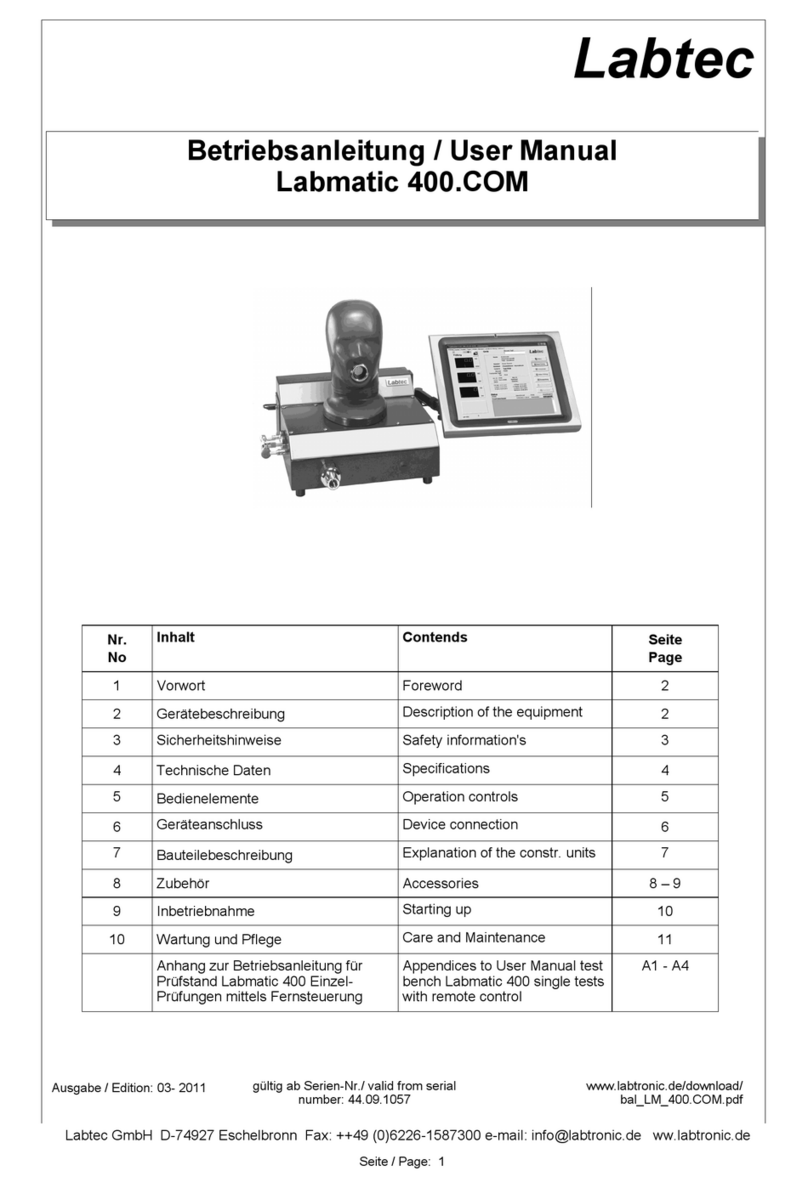User Manual LabModul 240 Page 2 www.labtec.de
1. foreword
This operating manual describes the operation
of LabModul 240 series of test instruments.
Labtec test devices are professional tools that
require comprehensive respiratory protection
expertise, e.g. by completing training as a re-
spirator maintenance technician, to ensure
proper operation and correct measurement.
A prerequisite for proper operation of the de-
vice is that the device is operated and used
exclusively in accordance with these operating
instructions. Labtec is not liable for personal
injury or damage to property or consequential
damage of any kind if the device is used in a
manner other than that described in this manu-
al. The same applies to the acceptance of any
warranty and guarantee claims.
Otherwise, the terms of sale and delivery as
well as the warranty and guarantee conditions
of Labtec GmbH apply, which are not exten-
ded in any way by these instructions.
2. safety instructions
Each Labtec test device requires device-
specific instruction by an authorized Labtec
employee or training partner.
The device may only be operated by instructed
and authorized personnel.
The device may only be serviced and repaired
by trained and certified Labtec service techni-
cians. Only original spare parts and accessori-
es must be used.
The device may only be opened by a Labtec
service technician or, if expressly requested,
under instruction by a Labtec employee.
To ensure proper functioning of the device and
thus a correct measurement result, the device
must be serviced at least once a year by a trai-
ned and certified Labtec service technician
and tested and calibrated by him or her using
a Labtec calibration device.
The list of current, certified employees, training
partners and service technicians is updated
daily and is available from Labtec or on the
Labtec homepage.
Labtec devices are partly operated with brea-
thing air in the high pressure range of up to
400bar. Operating a device under high pres-
sure requires the greatest care. Before
connecting and disconnecting a test item / bre-
athing apparatus, the test bench must always
be completely depressurized and air supply
lines, especially the main valve, closed.
The device connection must always be che-
cked. Devices must always be connected
completely correctly. When connecting to the
high pressure device connection, the device
thread must be completely screwed to the in-
ternal thread of the device connection.
Before switching off the test device electrically,
the test bench must first be completely depres-
surized and vented and then all connected de-
vices and any full face masks must be remo-
ved.
Never test dirty demand valves or masks on
the test head. There is a risk of dust particles
getting into the measuring system, which can
impair the function.
When the test stand is started up, the mouth
opening and the instrument connections must
remain open, otherwise self-calibration will be
incorrect and the measurement data will be
incorrect.
The test device must be set up horizontally
and rest well on all support buffers.
Care must be taken to ensure that the measu-
ring nozzle in the mouth opening in the test
head is not clogged. In case of false measu-
ring values in low pressure, the opening can
be cleaned with a 0.2 - 0.35 mm needle.
In case of queries or uncertainties
contact the Labtec customer service!




























